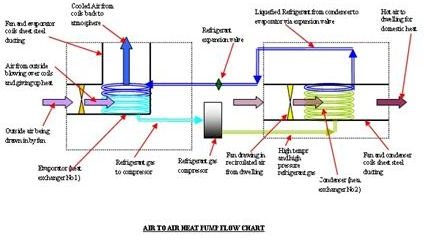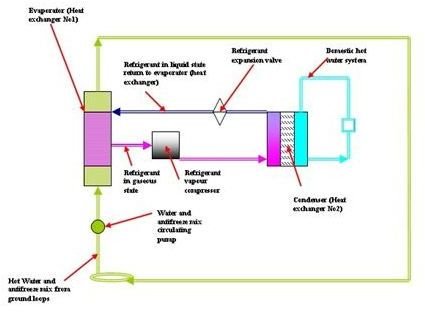Different Types of Heat Pump Systems for Heating Homes & How Ground Source Heat Pumps Work
Ground Source Heat Pump
A ground source heat pump extracts the heat from the ground through five different types of geothermal loops (previous article), the heat having been absorbed into the ground from the summer sun.
It uses this energy to supply heat to the dwelling hot water system, and in the form of under-floor heating, and it can also be used in the summer to cool the dwelling down by acting as an air conditioning unit.
GSHP Components and Design
A ground source heat pump comprises of the following components:
Refrigerant
This is a liquid with a much lower boiling point than water. Before we knew about CFCs affecting the ozone layer, the refrigerant used was a chlorofluorocarbon CFC such as R12 trade name Freon. Nowadays in our enlightened state we use a hydrochlorofluorocarbon HCFC such as R22, which should it escape to the atmosphere will not damage the ozone layer.
Evaporator
This is first of two heat exchangers used in the system, transferring heat from the ground loops to refrigerant. It causes the liquid refrigerant to evaporate ‘flashing off’ to a gas.
Expansion Valve
This device is fitted on the return line between the condenser and the evaporator. It fully expands the returning refrigerant to a liquid state.
Compressor
This compresses the refrigerant gas reducing the volume and increasing its temperature even higher than the evaporator.
Condenser
This is the second heat exchanger in the system where the now very hot refrigerant gas enters the exchanger passing its heat onto the hot water system thereby condensing back to liquid, before returning to the evaporator to start the cycle again.
Circulating Pump
This pump circulates the fluid through the loops and into the evaporator and back to loops.
Photovoltaic panel
As can be seen from above the only electrical power required in the system is for the compressor and circulating pump motors. To make the system completely green, we could use a PV panel to power both motors.
How Ground Source Heat Pumps Work
The operation of a ground source heat pump (sometimes called earth source heat pumps) consists of a series of liquids and gasses being pumped around in closed loops transferring heat from the ground to a refrigerant gas then to the household hot water system.
The heat from the ground is pumped through a heat exchanger known as the evaporator. This heat is transferred to the refrigerant and evaporating it into a gas, from here this gas is compressed in the compressor, an action necessary to increase its temperature further. This now very hot gas is forced through the condenser, which is in fact another heat exchanger, transferring its heat to the domestic hot water or under-floor heating system. This action turns the refrigerant gas back to a liquid which returns to the evaporator to start the cycle once again.
As stated above in components paragraph a photovoltaic panel can be incorporated into the heat pump system to make it a fully-fledged renewable energy scheme.
Air to Air Heat Pump (AAHP)
This is another type of heat pump which works in a similar manner to the GSHP described earlier, albeit using different components.
Refrigerant
The same type of refrigerant is used as in the GSHP (see page 1 for details).
Evaporator
In this case the evaporator is a set of coils in which the refrigerant circulates. Hot air from outside the house is drawn in and blown across the coils by a fan. This causes the refrigerant to evaporate flashing off to a gas.
Expansion Valve

This device is fitted on the return line between the condenser and the evaporator. It fully expands the returning refrigerant to a liquid state.
Compressor
The compressor compresses the gas raising its temperature further
Condenser
This is another set of coils through which the gas now passes through and a fan blows across the hot coils forcing the heated air into the house. The gas has now lost most of its heat and has been condensed to a liquid that returns to the evaporator and the cycle starts once again.
Thermostat
This is fitted outside the house and controls the heat pump, turning it off when the ambient air temperature becomes too low to operate the system.
Fans
There are two of these, one being used to draw in the outside air to heat the refrigerant and, the other to blow the heated refrigerant gas into the house. Both the coils and the fans are contained within sheet steel enclosures, known as HVAC ducting. (See sketch).
How Air-to-Air Heat Pumps Work
The operation of the air to air heat pump is basically as that of the GSHP, only this time the heat for the heat pump is extracted from the outside air. The refrigerant is passed through coils and evaporated to a gas through being heated by the outside ambient air which is drawn in and blown over the coils by a fan.
After passing through the evaporator the gas is then compressed to raise its temperature further before being forced through another set of coils which are subjected to a blast of air from another fan. This heated air is then ducted to the house being used as a form of hot air central heating.
The system can be reversed to become an air conditioning unit.
As with GSHP pump and compressor motors, the AAHP fans and compressor motors can be powered by a photovoltaic cell.
Which Heat Pump System is Best?
Of the two types of heat pumps described above the air to air is undoubtedly the cheapest to install due to the extensive excavations and down-hole drilling required to hold the various types of ground loops.
However the ground source heat pump has the advantage of being able to run throughout the year, albeit sometimes needing a boost from an electric immersion heater. The air to air heat pump has a thermostat which shuts down the system when the ambient temperature becomes to low to allow it to operate efficiently. This means a full back-up heating system of oil, gas or electric is required.
Both have reputedly a COP efficiency rating of geothermal energy (COP is a performance rating) greater than four but this is very much dependant on the ground and air temperatures. They are both forms of renewable energy.
This post is part of the series: Geothermal Energy - Energy from the Earth
This is a series about geothermal energy. It begins by examining how the heat is produced under the rocks and continues with itsextraction to tthe different types of geothermal power stations and how they operate. It continues with the different types of heat pumps and the loops that supply them
